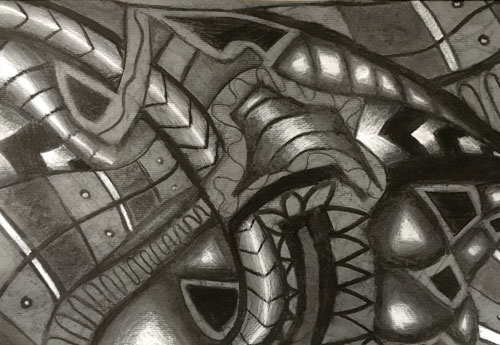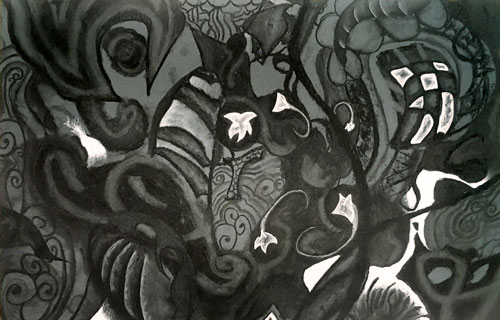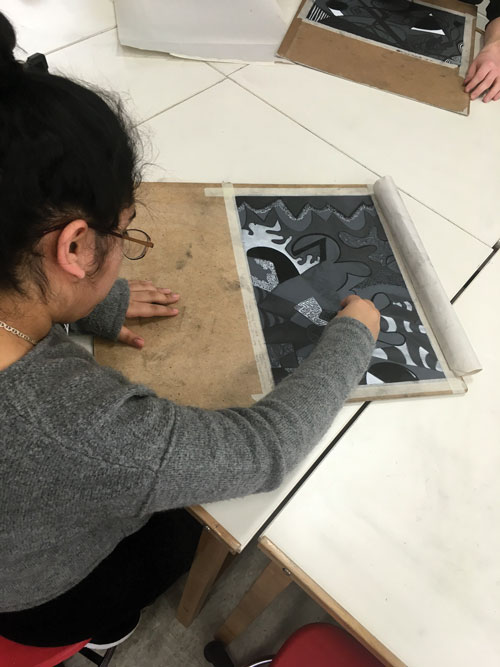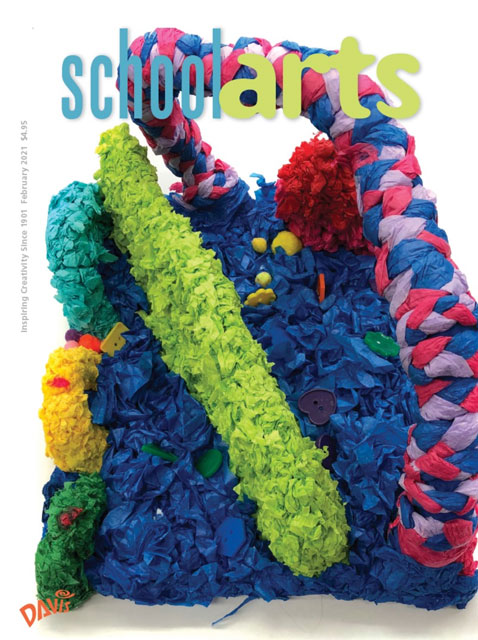 |
 |
| Top: Evan K., first abstract drawing, grade ten. Bottom: Citlalli R., grade ten, increases the contrast on her composition. |
“Draw with the vine and see how far it spreads when you run your thumb across it. Now try the pencil. What’s the difference? When might you use one over the other?” Talk about laying the tortillion on the angle to create smooth surfaces. Challenge them to create different marks by holding the materials in different ways. After ten minutes of experimenting, tell them to put their charcoal down.
Announce that the experimental mess in front of them is a graded assignment! Students may immediately freak out and reach for the erasers they don’t have. After a few moments, tell them to relax and that they will get through this together.
Discuss Abstract Expressionists
During the next class, discuss some of your favorite and least favorite abstract expressionist artists. Have open conversations about what you like and don’t like and, most importantly, why. Discuss how abstract artists experiment with the principles of design. This will be a theme that you will come back to often. One of my favorite videos to show is the Julie Mehretu video “Mural” through Art21. Mehretu talks about her mural having two viewing experiences: one experience from up close and a different experience from afar.
Create a Path Out of Trouble
Have students tape their paper to a board and give them basic rules of composition. Instruct them to write some of the rules on the tape as a constant reminder. Start with some very basic suggestions: going off the page, the rule of thirds, incorporating lots of variety, etc. As this project evolves, you can offer more composition suggestions based on common problems your students experience.
Create a Context
Ask students to describe their drawings. You might hear “horrible,” “messy,” and “chaotic.” Refer them back to the Mehretu video and instead of using the word “experience,” use the word “conversation” and ask the following questions:
- If your drawing were a conversation, what would it sound like?
- Is anyone talking to someone else? How do you know?
- If you close your eyes then open them quickly, where is your attention drawn? Is it the most interesting area or is it just the loudest?
-
Each of these questions can be answered with rules of composition and principles of design: repetition, reaction, contrast, focal point, etc.
 |
 |
| Top: Gabrielle O., grade eleven. Bottom: Caroline C., composition in progress, grade twelve. |
Give Them Hope and Confidence
It is important for students to realize that there is a way out of this mess. They just need to calm down, reason it out, and look for opportunities to move forward.
Say something like, “Every mark you make from this point on will have a purpose and strengthen your composition.”
Have Them Help Each Other
I do critiques every other day at the beginning of the lesson, some in large groups and some in pairs. You can write a script for them to follow. “You have thirty seconds to complain about your work, then your partner(s) will have one minute to respond with suggestions.”
This step is absolutely crucial to the process. It sets a precedent of seeking and offering advice; with any luck, this practice will carry on for the rest of the year. Critiques also give students who feel less confident about their abilities a chance to be helpful and have their opinions respected. If a student asks for help, think of other students in class who have dealt with the same issue and bring them into the conversation.
Let Them Earn Rewards
Students can earn erasers and white pencils by explaining how they intend to use them and how it will enhance or advance their composition.
Change the Perspective
Have students critique from different distances. New perspectives can completely change the “conversation.” Like Mehretu, you want to create a successful conversation from up close, and also from far away.
Allow Time for Reflection
After a week or two, build in one-day lessons and activities that take students’ minds off their compositions. This allows them time to reflect and see the work with fresh eyes. They will be more willing to rework areas after time has passed.
So much of this lesson is out of the teacher’s control and can be terrifying, but as my son told me, “Tightrope walkers have the best view.”
Thomas Dareneau is an art teacher at Boyertown Area Senior High School in Boyertown, Pennsylvania. tdareneau@boyertownasd.org
NATIONAL STANDARD
Creating: Organize and develop artistic ideas and work.
RESOURCE
Julie Mehretu: mariangoodman.com/artists/51-julie-mehretu/
View this article in the digital edition.






